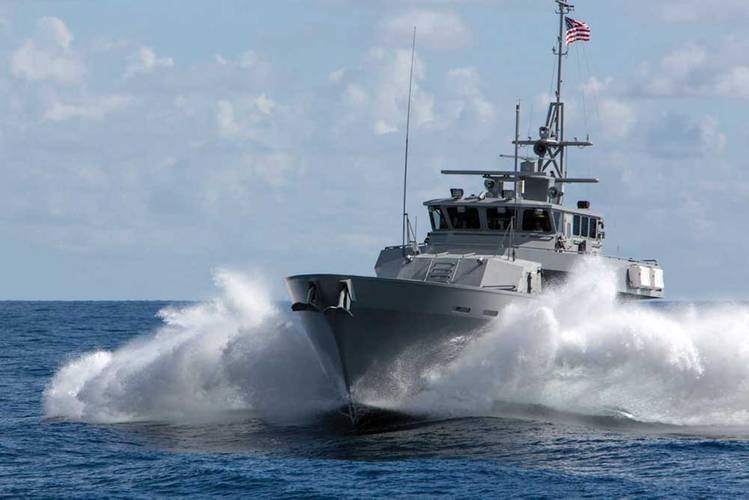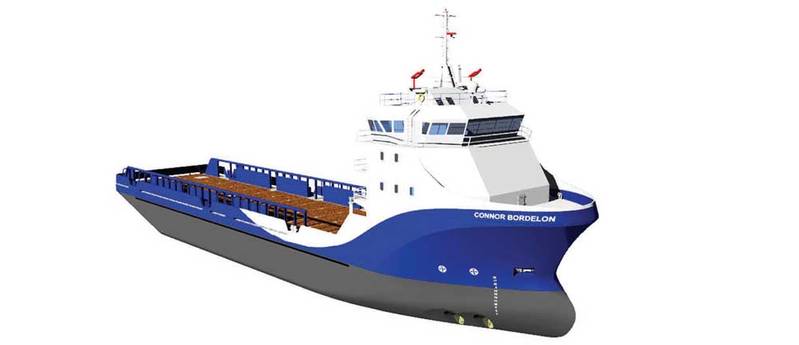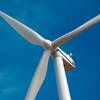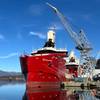The New Normal for GOM Offshore Vessels?
Offshore vessels in the Gulf of Mexico have become more energy efficient in recent years and are polluting less because of changes in engines, bunker fuels and building materials. At the same time, Gulf of Mexico builders have responded to meet new regulations, customer needs.
At Harvey Gulf International Marine in New Orleans, Environmental Compliance Coordinator Nicole Eddlemon said “adoption of energy-saving vessels in the U.S. is driven by North American Emission Control Area or ECA regulations, initiated by the Obama Administration and the U.S. Environmental Protection Agency, and by strict air permits for ‘major source’ oil rigs, customers striving to be greener and vessel operators wanting to save money on energy.” If that’s a mouthful; it’s also all true.
All vessels within 200 miles of the U.S. coast must comply with the EPA’s August 1 rules for low-sulfur fuel use, said Chad Verret, Senior Vice President for Alaska & Deepwater Operations at Harvey Gulf International. “The marine fuel they’re selling at Port Fourchon is now low-sulfur diesel.”
Tougher Standards? No Problem, says Harvey Gulf
Allowable sulfur content in diesel has declined to 10,000 parts per million, and in 2015 it drops to 1,000 ppm. The non-ECA, global limit is currently 35,000 ppm. But, Harvey Gulf’s Verret insists, “This new EPA rule doesn’t affect our liquid natural gas boats because LNG contains almost no sulfur. The LNG OSVs we’re delivering next year to the U.S. Gulf of Mexico market, for instance, are not affected.”
Much of today’s energy-saving focus is on engines. “Our company’s latest, delivered vessels have diesel electric TIER II engines that reduce emissions and optimize fuel consumption because of an improved engine power configuration,” Eddlemon said. “We delivered three 300’ class multipurpose offshore supply vessels, DPS-2 diesel electric, in 2011 and 2012, and have chartered each of them.” The company delivered the Harvey Supporter in December 2011, Harvey Sisuaq in April 2012 and Harvey Champion in August 2012.
Deepwater U.S. GOM is Introduced to LNG Supply Vessels
In mid-August, Harvey Gulf signed long-term charters for three of its LNG powered OSVs, and was the first U.S. company to contract LNG supply vessels in U.S. deep water. The Harvey Energy, Harvey Power and Harvey Liberty will be delivered in 2013 and 2014.
“The North Sea in the UK is very environment friendly and they’ve been using LNG vessels for years,” she said. “They’ve moved faster than the U.S.” She also noted that California’s diesel sulfur-content limits are stricter than North American ECA limits. California’s limit for marine diesel oil is 5,000 ppm.
“One of the reasons we geared up for LNG is because of very strict air emissions permits for ‘major source’ rigs,” Eddlemon said. If rigs in the EPA Outer Continental Shelf zone emit over 250 tons per year of pollutants, they are major source rigs, she explained. “Owners of these rigs must determine what their major pollutants--including NOx, SOx and CO2—are, and conduct a Best Achievable Control Technology or BACT analysis for them,” she said. Rig owners can be held to best-control procedures under their air permits.”
Eddlemon continued, “some rigs, depending on stipulations in their air permits, only allow vessels to burn low-sulfur fuel, and vessels can only stay near the rig for a limited time because of emissions limits in the rig’s air permits.” LNG contains almost no sulfur, and LNG used to fuel a vessel also emits less NOx or nitrogen oxide emissions, she said.
Thoma-Sea Taps Clients’ Environmental Needs
Thoma-Sea Marine Constructors, L.L.C. responded to market needs when it began building diesel electric OSVs that lower emissions and require less fuel. The Lockport, La. company is building a series of diesel-electric, offshore supply vessels now. Managing Director Walter Thomassie explains, “They’ll allow for reduced emissions based on an optimized hull design, and the efficiency of the power plant system allows the vessels to reduce fuel burn significantly over conventional designs.” The vessels have also earned the following class string-- ABS, AMS, A1, Circle E, Enviro, DP-2, FiFi-1, USCG Sub I & L.”
The first OSV in the series will be delivered at the end of the year, followed by one in July 2013, another in September 2013 and a fourth in January 2014. “When we began this program in late 2010, our decision to build was market driven,” Thomassie said. “Thoma-Sea and our customer at the time of design, Gulf Offshore Logistics, felt that we needed to offer a highly efficient, environmentally friendly option for servicing the offshore sector. The concept was developed in conjunction with Technology Associates, Inc. or TAI, the naval architects that did the engineering on the design.” TAI is headquartered in New Orleans.
In 2010, Thoma-Sea merged its Lockport and Houma, La. facilities under one entity, Thoma-Sea Marine Constructors. The company also recently sold two, diesel-electric-powered platform supply vessels to GulfMark Americas.
Bordelon Uses Engines That Reduce Emissions
Bordelon Marine Inc. is building three 252-foot PSVs in Houma, La., with engines that will reduce emissions, Wes Bordelon, President and CEO said. “We began the design process in 2010,” he said. “And even though it wasn’t a requirement at that time, we decided to make our new vessels Tier 3 compliant.” EPA Tier 3 emission standards reduce NOx and other emissions. The Stringrays’ propulsion will be supplied by two Cummins QSK 60-M, Tier 3-compliant diesel engines that each drive a Schottel 1215, 220 hp Z-Drive. Each vessel will have two Schottel STT2, 1020 hp bow thrusters.
“The Stingray design – ABS SOLAS classed, Full Oceans, L&I, ACCU, FIFI 1, DP2, AMS – utilizes special software and a combination of large and small generators to maximize fuel efficiency,” Bordelon said. “The vessel has the option to run on a single, low-horsepower generator, when operational power requirements are low.” The first Stingray will be delivered in January, the second in September 2013 and a third in January 2014.
Bordelon Marine provides transportation services to the oil and gas industry in the Gulf of Mexico and around the world. BMI offers offshore vessels supporting construction, exploration, production, ROV and dive, oceanographic research and military operations.
RiverHawk Uses Weight-Saving Materials To Cut Energy Use
Tampa, Fla.-based RiverHawk Fast Sea Frames, a builder of high-performance patrol craft, relies on environmentally friendly materials to produce naval and maritime security vessels, RiverHawk engineer Fabrizio Loi said. In early August, the company’s 43-meter, Advanced Multi-mission Platform or AMP completed acceptance trials in the Gulf of Mexico. In a nutshell, RiverHawk replaces traditional steel and aluminum materials with advanced composites to provide strength, stiffness and toughness for the hulls, decks and superstructures of its fast patrol boats, including the AMP and SeaStriker series vessels.
Weight-optimizing composite construction improves performance and reduces the environmental impact of ship operations, Loi said. “Benefits of the weight savings include increased payload capacity at the same gross weight, which results in reduced CO2 emissions per payload unit,” he said. “If increased payload is not a concern, weight savings result in reduced power needs, less fuel consumption and lower CO2 emissions.”
Texas-based James Jones, Americas Region Manager at Composites Consulting Group, said “CCG worked with RiverHawk and one of their contractors during the development of the AMP 45. Specifically, CCG consulted on fabrication of the composite hull using a vacuum-infusion process. DIAB structural-foam core materials were used throughout the hull to provide a lightweight, robust structure for the vessel and assist with the infusion process.” CCG is a division of DIAB Group, supplying structural core materials to marine, aerospace, transportation and other markets.
“Lighter, composite vessels reduce fuel consumption or allow for larger payloads or higher speeds at the same fuel consumption,” Jones said. Other benefits from using composite materials include reduced maintenance and lower lifecycle costs. Large vessels can utilize hybrid approaches, such as metal hulls and composite superstructures.
Feds Will Keep Pushing For Lower Emissions
Industry members said they’re keeping an eye on EPA emissions regulations, which will become increasingly stringent over the next decade. Builders will continue responding to the needs of clients, wishing to save on expensive fuel, and will use lighter construction materials when it’s possible. There’s more than one way to get green and more than one reason to do it. Those who embrace both concepts will likely be the long term winners in this increasingly competitive, highly regulated operating environment. That’s something you can take to the bank.
(As published in the September 2012 edition of Marine News - www.marinelink.com)


















